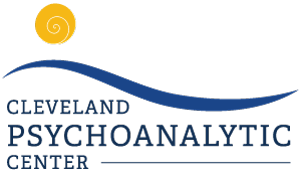Events in May at the Cleveland Psychoanalytic Center
 Analytic Flicks returns on Sunday, May 4th at 7:30 PM. Ingrid Geerken, Ph.D. will lead a discussion of "Railway Man," directed by Jonathan Teplitzky.Plot: Based on his best-selling memoir, the film tells the extraordinary and epic true story of Eric Lomax, a British Army officer who is tormented as a prisoner of war at a Japanese labor camp during World War II. Decades later, Lomax discovers that the Japanese interpreter he holds responsible for much... More of his treatment is still alive and sets out to confront him, and his haunting past.Please check movie listings for locations film is being shown.
Analytic Flicks returns on Sunday, May 4th at 7:30 PM. Ingrid Geerken, Ph.D. will lead a discussion of "Railway Man," directed by Jonathan Teplitzky.Plot: Based on his best-selling memoir, the film tells the extraordinary and epic true story of Eric Lomax, a British Army officer who is tormented as a prisoner of war at a Japanese labor camp during World War II. Decades later, Lomax discovers that the Japanese interpreter he holds responsible for much... More of his treatment is still alive and sets out to confront him, and his haunting past.Please check movie listings for locations film is being shown.  On Wednesday, May 7th, the Challenges Lecture Series continues with Christine Fowler Shearer, M.A. of Fowler Artistic Resources presenting
On Wednesday, May 7th, the Challenges Lecture Series continues with Christine Fowler Shearer, M.A. of Fowler Artistic Resources presenting
"Breaking with Tradition:Oho Women Artists"
Between 1870 and 1950 there were three major Ohio cities where women artists thrived: Cleveland, Columbus and Cincinnati. Each city encouraged many different styles, but these women excelled at their art despite the obstacles placed before them. This talk will look at some of these important, but largely forgotten, artists and discuss their life and impact on the arts during this period.Date: Wednesday Evening, May 7, 2014Time: 7:30 -- 9:00 p.m.Location: Cleveland Psychoanalytic CenterThis event is free and open to the public, but we encourage you to register by calling 216-229-5959 or email dmorsecpc@sbcglobal.netThe Cleveland Psychoanalytic Center is located in the Heights Medical Building at Cedar-Fairmount. Free parking is available behind the building.  On Friday evening, May 9th, join us for a Scientific Meeting with Aisha Abbasi, M.D., Training and Supervising Analyst, Michigan Psychoanalytic Institute. Dr. Abbasi will present:
On Friday evening, May 9th, join us for a Scientific Meeting with Aisha Abbasi, M.D., Training and Supervising Analyst, Michigan Psychoanalytic Institute. Dr. Abbasi will present:
“Action as Communication in the Psychoanalytic Process”
Brief description: For decades, we have been advised to recommend to our patients that they try to "say whatever comes to mind" while with their therapist/analyst. Useful as this basic injunction is, it ignores the fact that all patients communicate not only through words, but also via actions. Most clinicians recognize that some patients may communicate primarily through action for a long time. Other patients might, from time to time, weave particular actions into an otherwiseusual clinical interaction. In this paper, clinical material will be used to address a number of questions including, but not limited to: Why do some patients use action as the primary mode of communication? Why do others use action to communicate particular dilemmas, memories, and life experiences at certain points in their treatment? And how can we utilize a theoretical understanding of communication via action in order to usefully address the technical challenges this presents?Practice Gap: This program bridges a gap in psychoanalysis and psychotherapy, between a focus on words as the preferred method of communication of thoughts, feelings, memories and conflicts, and the fact that patients also use actions to convey all of the above. Though action and play are taken for granted as modes of communication when working with children, this has not routinely been so in therapeutic work with adults. This presentation will focus on helping attendees bridge the gap between our usual theory/technique of communication in the therapeutic setting, and what our patients often actually bring to our offices.Learning Objectives:Upon completion of this program:
- Attendees will develop a broader understanding of why certain patients, at certain times in their treatment, might use action as the predominant and preferred method of communication.
- Clinicians will be able to utilize theoretical concepts regarding different kinds of actions in treatment to identify techniques that facilitate preservation and deepening of the therapeutic process, and lead to understanding and useful change within the patient's mind.
- Program participants will learn the usefulness of monitoring their own countertransferences when working with action prone patients, and be able to use such reactions to better understand what is evolving within the therapeutic/analytic dyad and in the mind of the patient.
Aisha Abbasi, M.D. graduated from Fatima Jinnah Medical College in Lahore, Pakistan. She completed a residency in psychiatry at Henry Ford Hospital, Detroit, MI, and. trained to become a psychoanalyst at the Michigan Psychoanalytic Institute, where she is now a Training and Supervising Analyst. She teaches in the Psychiatry residency programs at the University of Michigan, Ann Arbor and Henry Ford Hospital, Detroit. Dr. Abbasi has presented and published on a variety of analytic topics, and is currently co-chair of a discussion group, “The Birth of an Analysis in the Mind of the Analyst: From Evaluation, to Recommendation, and Beyond,” which convenes annually at the national meetings of the American Psychoanalytic Association. Her collection of Urdu poetry, Ek Dunya Meray Andar Hai (The World Within), was published in Pakistan in 2007 and launched in the U.S. in 2009. In 2006 and 2012, she was awarded the Ira Miller Clinical Essay Award by the Michigan Psychoanalytic Society for clinical papers she presented at Society meetings. Her upcoming book, "The Rupture of Serenity: External Intrusions and Psychoanalytic Technique," will be released by Karnac Books (London) later this year. She lives and practices in West Bloomfield, MI.
